|
The first significant nuclear components are the protons and
neutrons. The second essential nuclear component is the alpha
particle, and the third essential nuclear component or structure is
the carbon ring. These are all lattice structures that are built
around the interactions of electromagnetic fields associated with
the up and down quarks. All nuclear structures are ultimately built
around the foundation particles quarks.
The color force holds the quarks together as protons and neutron
while the electromagnetic force arranges those protons and neutrons
into a hexagonal lattice like structure. The hexagonal structure is
the result of triangles formed by the three quarks that compose
protons and neutrons. The structural form that builds the nuclear
lattice is completely expressed in carbon12.
The nucleus forms a lattice structure based on the
interrelationship of electrical and magnetic fields of the quarks
that make up the protons and neutrons.
- The foundation components are up quarks represented by the
black nodes and down quarks represented by the white nodes.
- The first nuclear components are protons represented by two
black nodes connected to a white node with three blue struts, and
neutrons represented by two white nodes connected to a black node
with three white struts.
- The second component, the alpha particle, is made up of two
protons and two neutrons arranged in a two-layer, six sided lattice
structure of twelve quarks, six up quarks and six down quarks.
- The carbon12 ring could be considered a third nuclear
component. The carbon ring could be considered as the first
intermediate stage along the path of stable nuclei. The carbon ring
is a lattice structure consisting of three alpha particles
connected to form a ring.
|
 |
A=13
Generally a neutron is added before a proton because of the over all
positive charge on the nucleus. To this point the nucleus grows one
neutron followed by one proton at a time. This continues for two
more nuclei while the second carbon ring gets started. Add a neutron
to carbon C12 and carbon C13 results. This neutron adds on over a
proton above or below the first ring,
|
 |
A=14
Add a proton it attaches next to the neutron on the top of the
carbon ring and above a neutron to create nitrogen N14.
|
 |
A=15
Add a proton to magnesium Mg26 and create aluminum Al2Add a neutron
capping the new proton and generate nitrogen N157
|
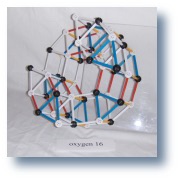 |
A=16
The addition of a proton creates an alpha particle attached to the
carbon ring, this results in oxygen O16. This is the last point
where neutrons and protons alternate as singles, thus ending the
deuteron step and starting the alpha step.
|
 |
A=17
Two neutrons are added to oxygen before another proton is added to
form fluorine. The first neutron is added where it joins the lower
proton in the alpha particle setting on the carbon ring, and caps a
proton in the carbon ring which makes O17.
|
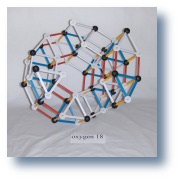 |
A=18
The next neutron is most likely added as a cap on the last exposed
proton on top of the carbon ring which creates O18.
|
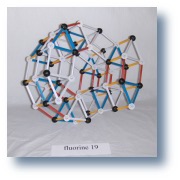 |
A=19
Add a proton to O18 to create fluorine F19. The proton is added next
to the alpha particle and on top of the neutron to reflect a
deuteron attached to the end of an alpha.
|
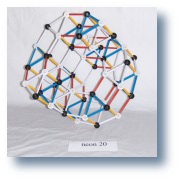 |
A=20
Add a proton to fluorine F19 next to the deuteron and between two
neutrons to create neon Ne20. There is every likely hood that the
lone neutron adjacent to this proton slides up to form a second
alpha particle in this growing second carbon ring.
|
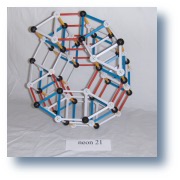 |
A=21
Again two neutrons are added to neon Ne20 to create first Ne21 and
Ne22.
|
 |
A=22
They are the start to filling the gap in the second carbon ring.
|
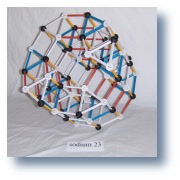 |
A=23
Adding a proton creates sodium Na23. The proton sits on the first
carbon ring.
|
 |
A=24
Adding one more proton to sodium Na23 the resulting nucleus is
magnesium Mg24. This proton also closes the second carbon ring. It
might be possible to split Magnesium Mg24 into two carbon C12
nuclei.
|
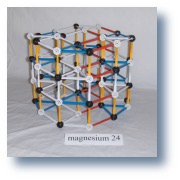
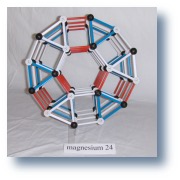
|
